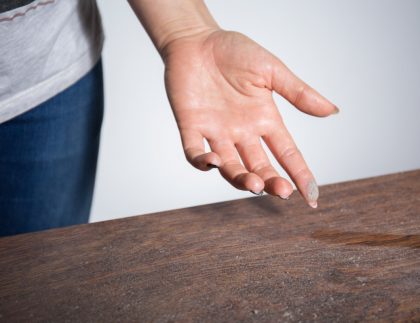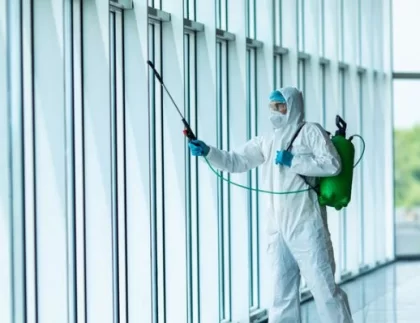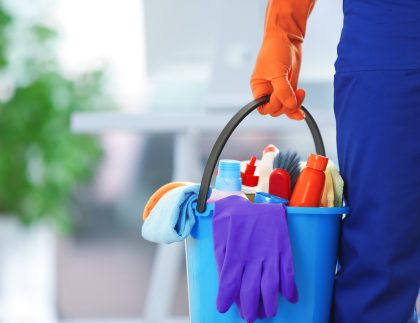
Simple Ways to Reduce Dust in the Office
Dust in the office is more than just a visual nuisance; it affects employee health, reduces indoor air quality, and can damage office equipment over time. It settles on desks, carpets, electronics, and furniture, creating an environment that can trigger allergies, respiratory issues, and eye irritation. Moreover, accumulated dust can shorten the lifespan of sensitive office equipment and create an unprofessional workspace.
Reducing dust effectively requires a multi-layered approach: daily cleaning, preventive measures, deep cleaning, and professional commercial cleaning support.
1. Office Surface Cleaning: Keep Dust from Settling
Surface dust accumulates quickly on desks, tables, shelves, and office equipment. Regular daily cleaning is the first line of defence. Using microfiber cloths is especially effective because they trap dust instead of merely spreading it.
Employees should be encouraged to clean their workstations daily, including keyboards, monitors, telephones, and shared equipment like printers and copiers. Even small items like office décor or file trays can collect dust, so wiping them regularly is important.
Tips for effective daily cleaning:
- Provide microfiber cloths and disinfectant sprays at every workstation.
- Schedule short cleaning breaks at the start or end of each day.
- Include commonly overlooked surfaces, like drawer handles and light switches.
Daily surface cleaning not only reduces dust but also supports a healthier and more hygienic workplace, enhancing productivity and employee well-being.
2. Vacuum Office Carpets and Rugs Thoroughly
arpets, rugs, and fabric-covered chairs are dust magnets. Ordinary vacuuming may remove surface dust, but professional office carpet cleaning with HEPA-filter vacuums is essential for trapping fine dust particles, allergens, and fibers embedded deep in fabrics.
High-traffic areas like entrances, hallways, and open-plan office zones require vacuuming at least two to three times a week. Less-used spaces, such as conference rooms, can be vacuumed weekly.
Additional tips:
- Move chairs and light furniture periodically to clean underneath.
- Use vacuum attachments for corners, edges, and under desks.
- Encourage employees to shake out small mats or chair covers to reduce trapped dust.
Regular vacuuming improves indoor air quality and complements other office dust cleaning practices.
3. Clean Office Air Vents and HVAC Ducts
HVAC systems can circulate dust and allergens throughout the office if not properly maintained. As part of regular office cleaning, air vents and ducts should be cleaned, and filters replaced according to manufacturer recommendations.
Installing HEPA filters in your HVAC system helps trap airborne dust and prevents it from spreading to different areas of the office.
Tips for effective air system maintenance:
- Schedule professional inspection and cleaning at least twice a year.
- Ensure vents are unobstructed and not blocked by furniture or equipment.
- Monitor airflow efficiency to maintain proper ventilation.
Clean air systems reduce airborne dust, creating a healthier work environment while supporting other dust control measures.
4. Place Doormats at Office Entrances
A significant portion of office dust is brought in from the outside via shoes, bags, and clothing. Installing high-quality doormats at all entrances reduces the amount of dirt and dust entering the office.
Tips for effective mat use:
- Encourage employees and visitors to wipe their feet thoroughly.
- Consider dual-mat systems or sticky mats at high-traffic entrances.
- Clean and replace mats regularly to maintain effectiveness.
Doormats are a simple, cost-effective preventive measure that minimizes dust at its source, supporting overall office dust cleaning efforts.
5. Encourage Clutter-Free Office Workstations
Cluttered desks provide more surfaces for dust to settle. Implementing a clean-desk policy encourages employees to store unnecessary items in drawers, cabinets, or shelves.
Tips for maintaining tidy workstations:
- Provide storage solutions like desk organizer’s, cabinets, and trays.
- Encourage employees to clear their desks at the end of the day.
- Include reminders for storing stationery, files, and office supplies properly.
A clutter-free environment reduces dust buildup, simplifies cleaning, and creates a professional workspace that boosts productivity and employee satisfaction.
6. Adopt a No-Shoes or Shoe-Cover Policy in the Office
Certain areas, such as server rooms, meeting rooms, and sensitive equipment zones, are highly prone to dust accumulation. Implementing a no-shoes policy or providing disposable shoe covers can prevent dust from entering these spaces.
Tips for implementation:
- Install automated shoe cover dispensers for convenience.
- Provide clear signage for designated no-shoes areas.
- Encourage staff compliance through awareness programs about dust reduction.
Preventing dust at the entry point of sensitive areas reduces cleaning frequency and protects delicate equipment.
7. Use Closed Office Storage Cabinets
Open shelves and racks are prone to dust accumulation. Using closed storage cabinets keeps files, stationery, and office equipment protected.
Additional tips:
- Wipe cabinet surfaces and handles regularly.
- Use labelled cabinets to organize files and materials efficiently.
- Keep frequently used items within reach but stored properly to reduce exposed surfaces.
Closed storage solutions not only reduce dust but also contribute to a neater and more professional office environment.
8. Educate Office Employees on Dust-Reducing Habits
Employee participation is critical for maintaining a dust-free office. Simple behavioral changes can significantly reduce dust accumulation.
Tips for employee engagement:
- Encourage clean-desk policies and proper storage of documents and office supplies
- Remind staff to wipe their personal electronics and workspace surfaces regularly
- Discourage eating at desks to prevent crumbs and dust accumulation
- Provide guidance on the proper handling of indoor plants and shared equipment
Educating employees fosters a collective responsibility for office dust cleaning, creating a cleaner and healthier environment while reducing reliance on professional services for minor maintenance.
9. Control Dust Through Proper Storage of Office Materials
Paper, files, and office supplies are a hidden source of dust if not stored properly. Loose stacks of paper and open shelving encourage dust accumulation.
Effective storage strategies:
- Use closed cabinets and drawers for documents and stationery
- Keep infrequently used items in sealed boxes or containers
- Rotate and clean storage areas periodically to remove settled dust
- Label storage for easier access and to reduce unnecessary handling
Proper storage minimizes dust exposure, protects materials, and contributes to a cleaner and more organized office environment.
Maintain a Dust-Free, Healthy Office Every Day
Dust is inevitable in any office, but it can be controlled effectively with a comprehensive strategy. Combining daily cleaning, preventive measures, strategic workspace planning, deep cleaning, and professional support keeps your office dust-free and healthy.
A dust-free office is not just about appearances; it protects employee health, prolongs the life of equipment, and enhances overall productivity. Encouraging participation from employees, implementing clear policies, and partnering with professional services like The Cleanables ensures long-term results.
Consistency, diligence, and a combination of practical strategies are key to maintaining a clean, safe, and professional office environment.










